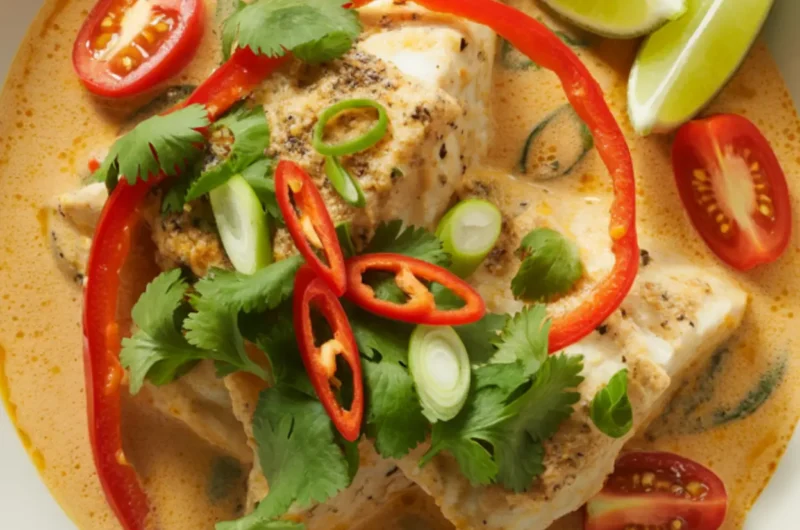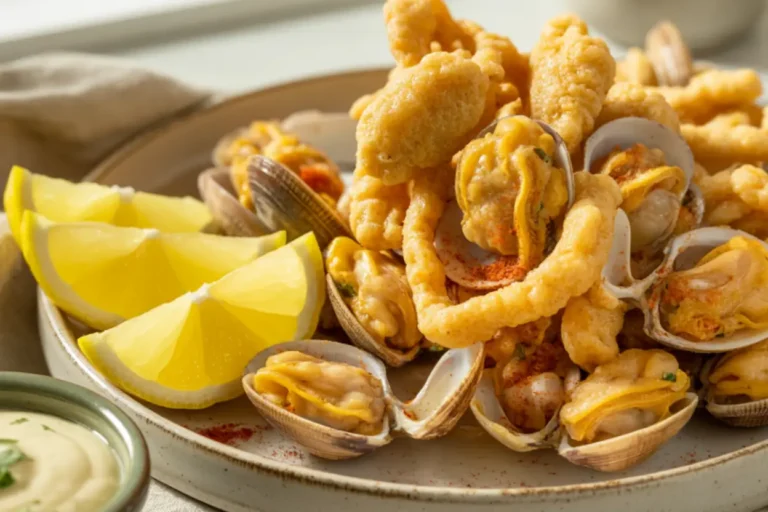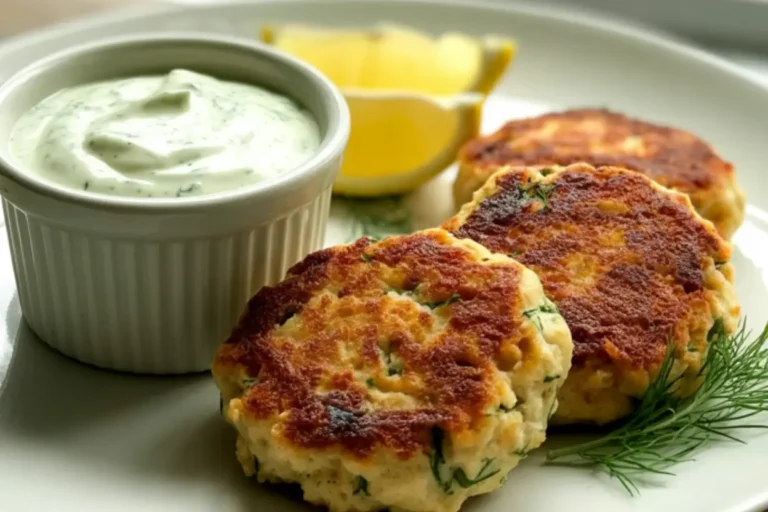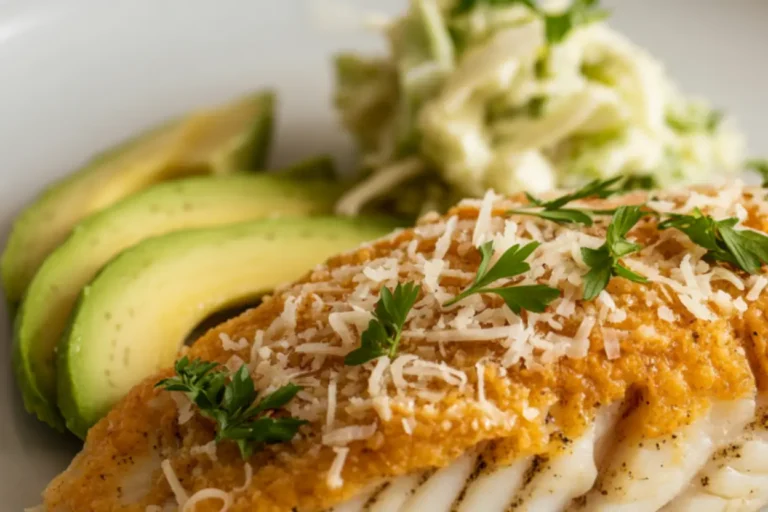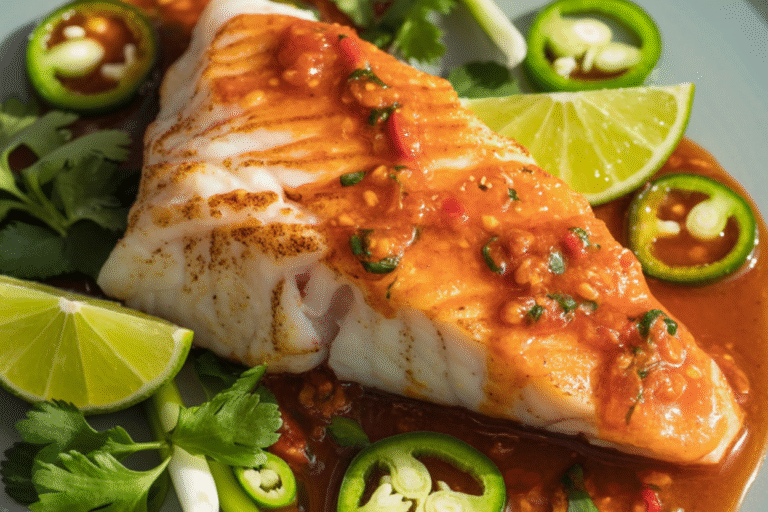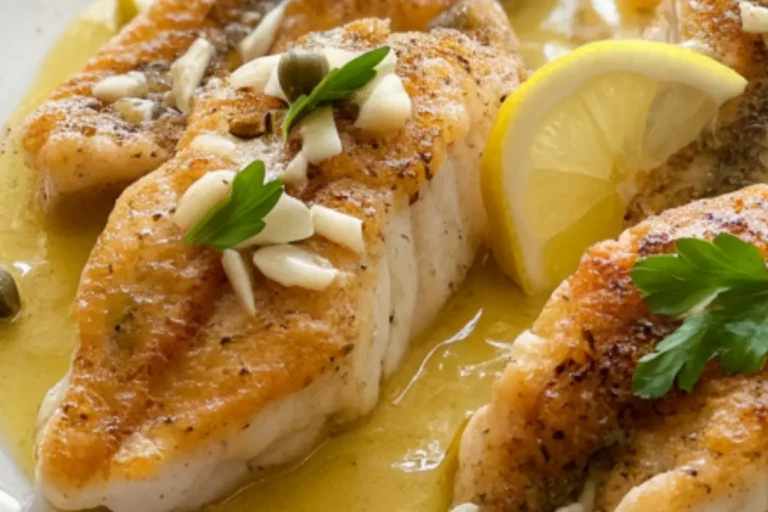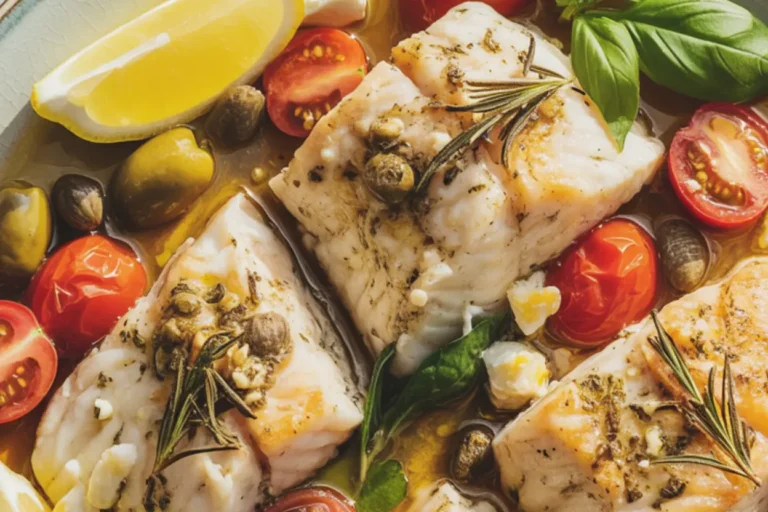Bill Granger’s Coconut Fish Curry: How to Make It Perfect
Table of Contents
There’s something magical about a perfectly balanced coconut fish curry that transports you straight to the sun-drenched shores of Southeast Asia. Bill Granger, the Australian restaurateur and cookbook author known for his fresh, simple approach to cooking, has created a coconut fish curry recipe that embodies this culinary magic. His signature dish combines tender fish with aromatic spices in a silky coconut sauce that’s both comforting and exotic.
Thank you for reading this post, don't forget to subscribe!In this comprehensive guide, I’ll walk you through recreating Bill Granger’s coconut fish curry in your own kitchen, sharing professional insights to ensure your curry turns out perfectly every time. Whether you’re an experienced cook or just beginning your culinary journey, this recipe will become a treasured addition to your repertoire.
How to Make Bill Granger’s Coconut Fish Curry
Quick Overview
Bill Granger’s coconut fish curry is the epitome of accessible gourmet cooking – it delivers exceptionally vibrant flavors while remaining surprisingly simple to prepare. What makes this curry truly special is its perfect balance of creaminess from the coconut milk, delicate fish texture, and the aromatic depth of the curry paste. The sauce achieves that coveted silky consistency that coats each piece of fish beautifully without being overly heavy.
Unlike many complex curry recipes that require hours of simmering, Bill’s version comes together in just about 30 minutes, making it ideal for both weeknight dinners and casual entertaining. The preparation is simple enough for beginners, but the finished dish is elegant enough to impress even the most refined dinner guests. With just 10 minutes of prep and 20 minutes of cooking, you can have a restaurant-worthy meal ready in no time.
The Ingredients I Use to Bring My Bill Granger’s Coconut Fish Curry to Life
To create this delicious curry, you’ll need:
For the curry base:
- 1.5 lbs (700g) firm white fish fillets (such as cod, haddock, or snapper)
- 2 tablespoons vegetable oil
- 1 large onion, finely chopped
- 3 garlic cloves, minced
- 1-inch piece ginger, finely grated
- 2-3 tablespoons Thai red curry paste (adjust according to heat preference)
- 1 red bell pepper, sliced into thin strips
- 1 can (14 oz/400ml) coconut milk (full-fat for best results)
- 1 tablespoon fish sauce
- 1 tablespoon brown sugar or palm sugar
- Juice of 1 lime
- 1 cup cherry tomatoes, halved
For garnishing:
- Fresh cilantro leaves, roughly chopped
- 1-2 red chilies, thinly sliced (optional)
- Lime wedges
- 2 scallions/green onions, finely sliced
Step-by-Step Instructions
Preparing the Fish and Vegetables
- Prepare the fish: Pat the fish fillets dry with paper towels. This step is crucial for ensuring your fish doesn’t release too much moisture into the curry. Cut the fillets into 2-inch (5cm) chunks and lightly season with salt. Set aside in the refrigerator while you prepare the curry base.
- Prep the aromatics: Finely chop the onion, mince the garlic, and grate the ginger. Having these aromatics ready before you start cooking will make the process much smoother.
- Slice the vegetables: Cut the red bell pepper into thin strips and halve the cherry tomatoes. Slice the scallions and chilies (if using) for garnish and set aside.
Creating the Curry Base
- Heat the oil: In a large, deep skillet or wok, heat the vegetable oil over medium heat until shimmering.
- Sauté the aromatics: Add the chopped onion to the hot oil and sauté for 3–4 minutes until it becomes soft and translucent. Stir in the minced garlic and grated ginger, cooking for another minute until aromatic. Keep an eye on the garlic to prevent it from burning, as it can turn bitter quickly.
- Add the curry paste: Add the Thai red curry paste to the pan and stir constantly for 1-2 minutes, allowing the paste to toast slightly and release its fragrant oils. This “blooming” of the curry paste is essential for developing deep flavor in your curry.
- Incorporate the vegetables: Add the sliced red bell pepper to the pan and cook for 2 minutes, stirring occasionally, until it begins to soften.
Creating the Curry Sauce
- Add the coconut milk: Pour in the coconut milk, stirring well to combine with the curry paste mixture. Bring to a gentle simmer over medium heat.
- Season the sauce: Stir in the fish sauce, brown sugar, and half the lime juice. Allow the sauce to simmer gently for about 5 minutes, letting the flavors meld and the sauce reduce slightly.
- Add the tomatoes: Gently fold in the cherry tomatoes and simmer for another 2 minutes, just until the tomatoes begin to soften but still hold their shape.
Cooking the Fish
- Add the fish: Gently place the fish chunks into the simmering curry sauce, making sure they’re mostly submerged. Cover the pan and reduce the heat to low.
- Poach the fish: Let the fish simmer gently in the sauce for about 5–7 minutes, adjusting the time based on the thickness of your fillets. It’s fully cooked when it becomes opaque and flakes easily with a fork.
- Final seasoning: Once the fish is cooked, carefully taste the sauce (avoiding disturbing the fish too much) and adjust with more fish sauce if needed for saltiness, sugar for sweetness, or lime juice for acidity.
Serving
- Garnish the curry: Remove the curry from the heat and sprinkle with fresh cilantro leaves, sliced scallions, and optional red chili slices.
- Serve immediately: Transfer to a serving dish or individual bowls and provide lime wedges on the side for guests to add more citrus according to their preference.
What to Serve Bill Granger’s Coconut Fish Curry With
Bill Granger’s coconut fish curry pairs beautifully with several complementary sides:
- Steamed Jasmine Rice: The classic accompaniment, jasmine rice’s floral aroma and light texture make it perfect for soaking up the flavorful curry sauce.
- Coconut Rice: For an even more indulgent experience, serve with coconut rice cooked in light coconut milk with a pinch of salt and a kaffir lime leaf.
- Roti or Naan Bread: Though not traditionally Southeast Asian, these flatbreads are wonderful for scooping up the sauce.
- Fresh Cucumber Salad: A simple side of sliced cucumbers dressed with rice vinegar, a touch of sugar, and fresh mint offers a cooling contrast to the curry’s warmth.
- Steamed Bok Choy or Asian Greens: Lightly steamed and drizzled with sesame oil, these provide a nutritious green element to balance the meal.
For beverages, consider serving:
- A crisp Riesling or Gewürztraminer wine
- Thai iced tea
- Coconut water with a squeeze of lime
- A light lager or pilsner beer
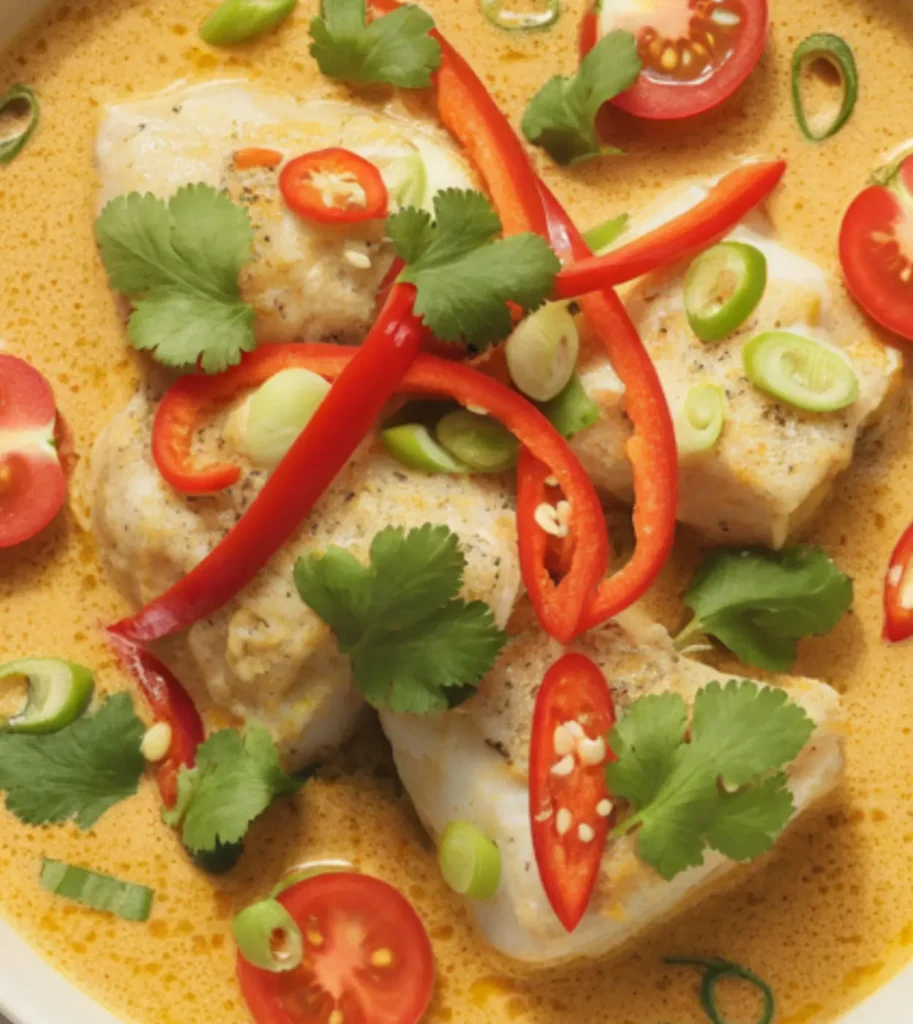
Top Tips for Perfecting Bill Granger’s Coconut Fish Curry
After making this curry countless times, I’ve gathered several professional tips that will help you achieve curry perfection:
- Choose the right fish: Firm white fish varieties work best in this curry. Cod, haddock, snapper, or sea bass all hold their shape well during cooking. Avoid delicate fish like sole or flounder, which can fall apart too easily in the sauce.
- Control the heat level: Thai curry pastes vary significantly in spiciness between brands. If you’re unsure, start with less paste and add more after tasting the sauce. You can always increase the heat, but you can’t take it away once added!
- Don’t skip the fish sauce: While it has a potent smell in the bottle, fish sauce adds essential umami depth to the curry. There’s really no proper substitute, though in a pinch, you could use light soy sauce with a pinch of salt.
- Use full-fat coconut milk: Light coconut milk simply won’t provide the same rich, creamy texture that makes this curry special. For an authentic result, always opt for full-fat.
- Timing is everything with fish: The most common mistake with this recipe is overcooking the fish. Since the residual heat from the sauce will continue to cook it after it’s removed from the stove, it’s better to slightly undercook it than risk drying it out.
- Ingredient substitutions:
- No red bell pepper? Yellow or orange peppers work well too.
- Cherry tomatoes can be replaced with regular tomatoes, deseeded and chopped.
- In place of palm sugar, you can use brown sugar or even a touch of maple syrup.
- If lime is unavailable, lemon juice can work in a pinch.
- Balance the flavors: The perfect curry has a harmonious balance of salty (fish sauce), sweet (sugar), sour (lime), and spicy (curry paste) elements. Taste and adjust these components before serving.
Storing and Reheating Tips
While Bill Granger’s coconut fish curry is best enjoyed fresh from the stove, sometimes you might have leftovers or want to prepare it ahead of time:
Refrigeration: If you have leftovers, allow the curry to cool completely before transferring to an airtight container. Keep refrigerated and consume within 2 days. The flavors actually develop nicely overnight, though the fish texture won’t be quite as perfect as when freshly made.
Freezing considerations: This curry doesn’t freeze well once the fish is added, as the texture of the fish deteriorates significantly upon thawing. However, you can freeze the curry sauce without the fish:
- Prepare the recipe through step 10 (before adding the fish)
- Cool the sauce completely
- Store in an airtight container and freeze for up to 3 months.
- When ready to use, thaw overnight in the refrigerator, reheat gently, and then add fresh fish to complete the dish
Reheating method: To reheat leftover curry with fish:
- Place the curry in a saucepan over low heat
- If the sauce becomes too thick, stir in a splash of coconut milk or water to loosen it.
- Heat gently until just warmed through, being careful not to bring it to a boil, which would toughen the fish
- Stir minimally to avoid breaking up the fish pieces
Make-ahead strategy: If preparing for guests, consider making the curry sauce a day ahead, refrigerating it, and then reheating gently before adding fresh fish just before serving. This gives you the benefits of developed flavors while maintaining the perfect fish texture.
Storage tip: If you know you’ll have leftovers, consider removing a portion of the sauce before adding the fish. Refrigerate or freeze this sauce separately, then add fresh fish when reheating for a much better result than reheating fish that’s already been cooked.
By following these detailed instructions and professional tips, you’ll create a Bill Granger’s coconut fish curry that rivals the original. This aromatic, creamy dish balances simplicity and sophisticated flavor, making it perfect for both weeknight meals and special occasions. The beauty of this curry lies in its adaptability – once you master the basic technique, you can adjust the flavors to suit your palate and experiment with different fish varieties while maintaining that signature Bill Granger touch of casual elegance.
click here to follow me on pinterest
Bill Granger’s Coconut Fish Curry: How to Make It Perfect
Cuisine: Modern Asian / Thai-inspiredDifficulty: Easy to Moderate4
servings15
minutes20
minutes400-450
kcalThis vibrant and fragrant coconut fish curry is a beautiful fusion of Thai-inspired flavors and tender white fish fillets simmered in a rich, creamy coconut milk sauce. The warmth of red curry paste is perfectly balanced with sweet cherry tomatoes, zesty lime, and the subtle sweetness of palm sugar, creating a comforting yet light dish ideal for any night of the week.
Ingredients
1.5 lbs (700g) firm white fish fillets (such as cod, haddock, or snapper)
2 tablespoons vegetable oil
1 large onion, finely chopped
3 garlic cloves, minced
1-inch piece ginger, finely grated
2-3 tablespoons Thai red curry paste (adjust according to heat preference)
1 red bell pepper, sliced into thin strips
1 can (14 oz/400ml) coconut milk (full-fat for best results)
1 tablespoon fish sauce
1 tablespoon brown sugar or palm sugar
Juice of 1 lime
1 cup cherry tomatoes, halved
Fresh cilantro leaves, roughly chopped
1-2 red chilies, thinly sliced (optional)
Lime wedges
2 scallions/green onions, finely sliced
Instructions
- Prepare Fish and Vegetables
Pat the fish dry, cut into chunks, and season lightly with salt. Refrigerate while prepping. Finely chop the onion, mince the garlic, grate the ginger, slice the bell pepper, halve the tomatoes, and prep scallions and chilies for garnish. - Build the Curry Base
Heat oil in a deep skillet or wok over medium heat. Sauté onion for 3–4 minutes until soft, then add garlic and ginger. Stir in Thai red curry paste and cook for 1–2 minutes to release its flavor. Add bell pepper and cook for another 2 minutes. - Make the Sauce
Pour in the coconut milk and bring to a gentle simmer. Stir in fish sauce, brown sugar, and half the lime juice. Let simmer for 5 minutes. Add cherry tomatoes and cook for 2 more minutes until they begin to soften. - Cook the Fish
Gently add the seasoned fish to the sauce, cover, and reduce the heat. Simmer for 5–7 minutes, or until the fish is opaque and flakes easily. Taste and adjust seasoning with more lime juice, fish sauce, or sugar as needed. - Garnish and Serve
Remove from heat and top with cilantro, scallions, and red chilies (if using). Serve hot with lime wedges on the side for an extra burst of citrus.
Notes
- This dish is all about balance; creamy coconut milk, spicy red curry, sweet tomatoes, and tangy lime juice come together to create a flavorful, comforting meal. Feel free to adjust the amount of curry paste to suit your spice tolerance. Use a firm white fish like cod, haddock, or snapper to ensure it holds together well in the curry. Serve it with steamed jasmine rice for a complete and satisfying meal.


